1.2E: Exercises
- Page ID
- 17302
1.2E: Exercises
Exercises
For the following exercises, for each pair of points, a. find the slope of the line passing through the points and b. indicate whether the line is increasing, decreasing, horizontal, or vertical.
59) \((-2,4)\) and \((1,1)\)
- Answer:
- a. −1 b. Decreasing
- Answer:
- \(a. −1 \\b. Decreasing\)
60) \((-1,4)\) and \((3,-1)\)
61) \((3,5)\) and \((-1,2)\)
- Answer:
- a. 3/4 b. Increasing
62) \((6,4)\) and \((4,-3)\)
63) \((2,3)\) and \((5,7)\)
- Answer:
- a. 4/3 b. Decreasing
64) \((1,9)\) and \((-8,5)\)
65) \((2,4)\) and \((1,4)\)
- Answer:
- a. 0 b. Horizontal
66) \((1,4)\) and \((1,0)\)
For the following exercises, write the equation of the line satisfying the given conditions in slope-intercept form.
67) Slope =\(−6\), passes through \((1,3)\)
- Answer:
- \(y=−6x+9\)
68) Slope =\(3\), passes through \((-3,2)\)
69) Slope =\(\frac{1}{3}\), passes through \((0,4)\)
- Answer:
- \(y=\frac{1}{3}x+4\)
70) Slope =\(\frac{2}{5}\), \(x\)-intercept =\(8\)
71) Passing through \((2,1\) and \((−2,−1)\)
- Answer:
- \(y=\frac{1}{2}x\)
Solution: \(y=\frac{1}{2}x\)
72) Passing through \((−3,7)\) and \((1,2)\)
73) \(x\)-intercept =\(5\) and \(y\)-intercept =\(−3\)
- Answer:
- \(y=\frac{3}{5}x−3\)
74) \(x\)-Intercept =−\(6\) and \(y\)-intercept =\(9\)
For the following exercises, for each linear equation, a. give the slope \(m\) and \(y\)-intercept b, if any, and b. graph the line.
75) \(y=2x−3\)
- Answer:
-
a. \((m=2,b=−3)\)
b.
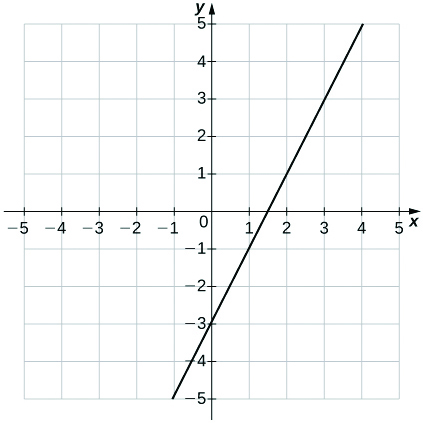
76) \(y=−\frac{1}{7}x+1\)
77) \(f(x)=-6x\)
- Answer:
-
a. \((m=−6,b=0)\)
b.
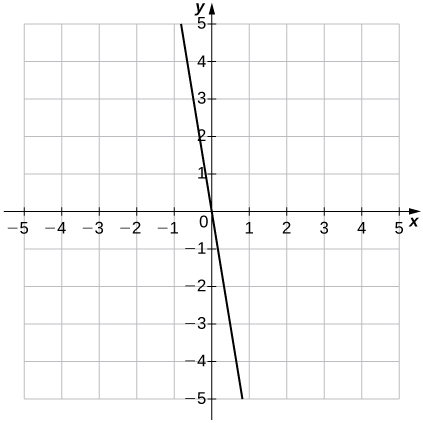
a. \((m=−6,b=0)\)
b.
78) \(f(x)=−5x+4\)
79) \(4y+24=0\)
- Answer:
- a. \(m=0\) b.
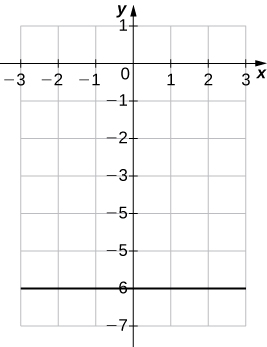
80) \(8x-4=0\)
81) \(2x+3y=6\)
- Answer:
-
a. \((m=−\frac{2}{3},b=2)\)
b.
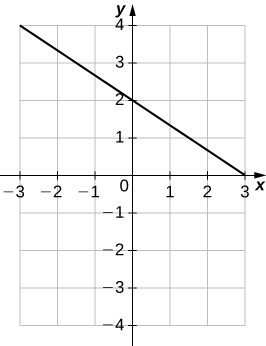
82) \(6x−5y+15=0\)
For the following exercises, for each polynomial, a. find the degree; b. find the zeros, if any; c. find the \(y\)-intercept(s), if any; d. use the leading coefficient to determine the graph’s end behavior; and e. determine algebraically whether the polynomial is even, odd, or neither.
83) \(f(x)=2x^2−3x−5\)
- Answer:
- \(a. 2\\ b. \frac{5}{2},−1; \\ c. −5 \\ d. Both\; ends \; rise \\ e. Neither \)
84) \(f(x)=−3x^2+6x\)
85) \(f(x)=\frac{1}{2}x^2−1\)
- Answer:
- \(a. 2 \\ b. ±\sqrt{2} \\ c. −1 \\ d. Both \; ends\; rise \\ e. Even\)
86) \(f(x)=x^3+3x^2−x−3\)
87) \(f(x)=3x−x^3\)
- Answer:
- \(a. 3 \\ b. 0, ±\sqrt{3} \\ c. 0 \\ d. \mbox{ Left end rises, right end falls } \\ e. Odd\)
For the following exercises, use the graph of \(f(x)=x^2\) to graph each transformed function \(g\).
Exercise:
88) \(g(x)=x^2−1\)
89) \(g(x)=(x+3)^2+1\)
- Answer:
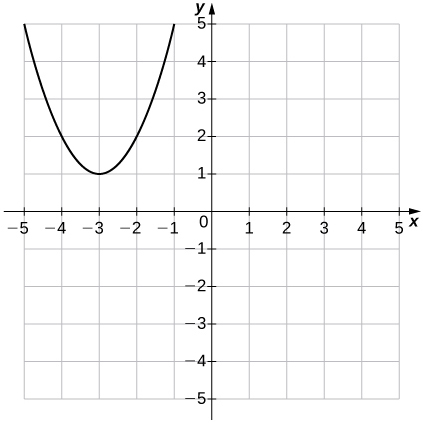
For the following exercises, use the graph of \(f(x)=\sqrt{x}\) to graph each transformed function \(g\).
90) \(g(x)=\sqrt{x+2}\)
91) \(g(x)=−\sqrt{x}−1\)
- Answer:
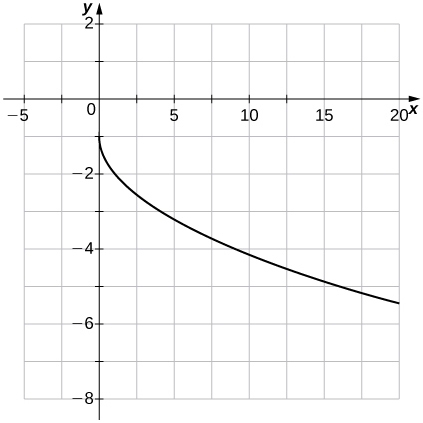
For the following exercises, use the graph of \(y=f(x)\) to graph each transformed function \(g\).
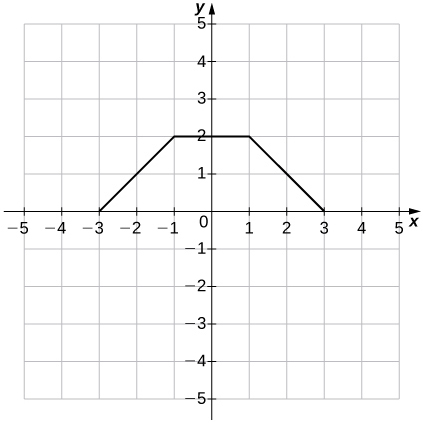
92) \(g(x)=f(x)+1\)
93) \(g(x)=f(x−1)+2\)
- Answer:
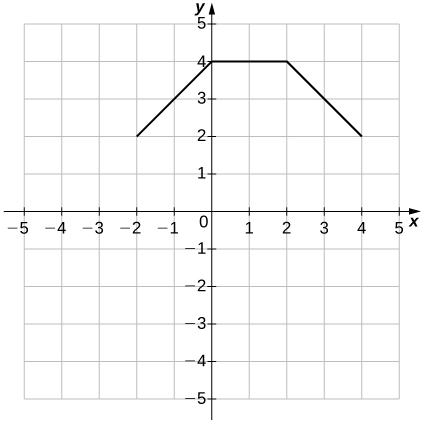
For the following exercises, for each of the piecewise-defined functions, a. evaluate at the given values of the independent variable and b. sketch the graph.
94) \(f(x)=\begin{cases}4x+3, & x≤0\\ -x+1, & x>0\end{cases} ;f(−3);f(0);f(2)\)
95) \(f(x)=\begin{cases}x^2-3, & x≤0\\ 4x+3, & x>0\end{cases} ;f(−4);f(0);f(2)\)
- Answer:
-
a. \(13,−3,5\)
b.
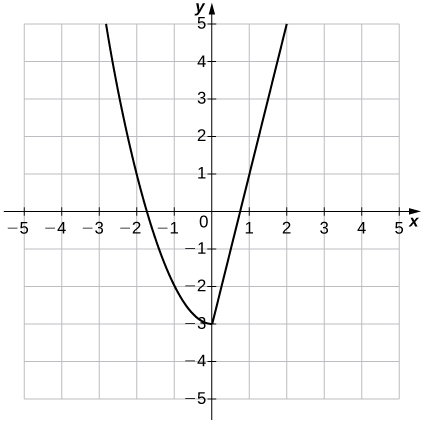
96) \(h(x)=\begin{cases}x+1, &x≤5\\4, &x>5\end{cases} ;h(0);h(π);h(5)\)
97) \(g(x)=\begin{cases}\frac{3}{x−2}, &x≠2\\4, &x=2\end{cases} ;g(0);g(−4);g(2)\)
- Answer:
-
a. \(\frac{−3}{2},\frac{−1}{2},4\)
b.
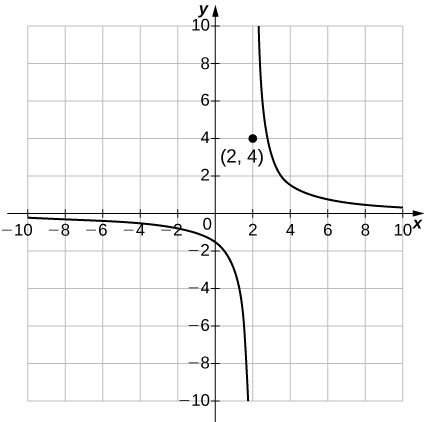
For the following exercises, determine whether the statement is true or false. Explain why.
98) \(f(x)=(4x+1)/(7x−2)\) is a transcendental function.
99) \(g(x)=\sqrt[3]{x}\) is an odd root function
- Answer:
- True; \(n=3\)
100) A logarithmic function is an algebraic function.
101) A function of the form \(f(x)=x^b\), where \(b\) is a real valued constant, is an exponential function.
- Answer:
- False; \(f(x)=x^b\), where \(b\) is a real-valued constant, is a power function
102) The domain of an even root function is all real numbers.
103) [T] A company purchases some computer equipment for $20,500. At the end of a 3-year period, the value of the equipment has decreased linearly to $12,300.
a. Find a function \(y=V(t)\) that determines the value V of the equipment at the end of t years.
b. Find and interpret the meaning of the \(x\)- and \(y\)-intercepts for this situation.
c. What is the value of the equipment at the end of 5 years?
d. When will the value of the equipment be $3000?
- Answer:
- \(a. V(t)=−2733t+20500 \\ b. (0,20,500) \mbox{ means that the initial purchase price of the equipment is } $20,500; (7.5,0) \mbox{ means that in 7.5 years the computer equipment has no value. } \\ c. $6835 \\ d. \mbox{ In approximately } 6.4 \mbox{ years.}\)
104) [T] Total online shopping during the Christmas holidays has increased dramatically during the past 5 years. In 2012 \((t=0)\),total online holiday sales were $42.3 billion, whereas in 2013 they were $48.1 billion.
a. Find a linear function S that estimates the total online holiday sales in the year t.
b. Interpret the slope of the graph of S.
c. Use part a. to predict the year when online shopping during Christmas will reach $60 billion.
105) [T] A family bakery makes cupcakes and sells them at local outdoor festivals. For a music festival, there is a fixed cost of $125 to set up a cupcake stand. The owner estimates that it costs $0.75 to make each cupcake. The owner is interested in determining the total cost \(C\) as a function of number of cupcakes made.
a. Find a linear function that relates cost C to x, the number of cupcakes made.
b. Find the cost to bake 160 cupcakes.
c. If the owner sells the cupcakes for $1.50 apiece, how many cupcakes does she need to sell to start making profit? (Hint: Use the INTERSECTION function on a calculator to find this number.)
- Answer:
- \( a. C=0.75x+125 \\ b. $245 \\ c. 167 cupcakes\)
106) [T] A house purchased for $250,000 is expected to be worth twice its purchase price in 18 years.
a. Find a linear function that models the price P of the house versus the number of years t since the original purchase.
b. Interpret the slope of the graph of P.
c. Find the price of the house 15 years from when it was originally purchased.
107) [T] A car was purchased for $26,000. The value of the car depreciates by $1500 per year.
a. Find a linear function that models the value V of the car after t years.
b. Find and interpret \(V(4)\).
- Answer:
- a. \(V(t)=−1500t+26,000\) b. In 4 years, the value of the car is $20,000.
108) [T] A condominium in an upscale part of the city was purchased for $432,000. In 35 years it is worth $60,500. Find the rate of depreciation.
109) [T] The total cost C (in thousands of dollars) to produce a certain item is modeled by the function \(C(x)=10.50x+28,500\), where x is the number of items produced. Determine the cost to produce 175 items.
- Answer:
- $30,337.50
110) [T] A professor asks her class to report the amount of time t they spent writing two assignments. Most students report that it takes them about 45 minutes to type a four-page assignment and about 1.5 hours to type a nine-page assignment.
a. Find the linear function \(y=N(t)\) that models this situation, where \(N\) is the number of pages typed and t is the time in minutes.
b. Use part a. to determine how many pages can be typed in 2 hours.
c. Use part a. to determine how long it takes to type a 20-page assignment.
111) [T] The output (as a percent of total capacity) of nuclear power plants in the United States can be modeled by the function \(P(t)=1.8576t+68.052\), where t is time in years and \(t=0\) corresponds to the beginning of 2000. Use the model to predict the percentage output in 2015.
- Answer:
- 96% of the total capacity
112) [T] The admissions office at a public university estimates that 65% of the students offered admission to the class of 2019 will actually enroll.
a. Find the linear function \(y=N(x)\), where \(N\) is the number of students that actually enroll and \(x\) is the number of all students offered admission to the class of 2019.
b. If the university wants the 2019 freshman class size to be 1350, determine how many students should be admitted.

